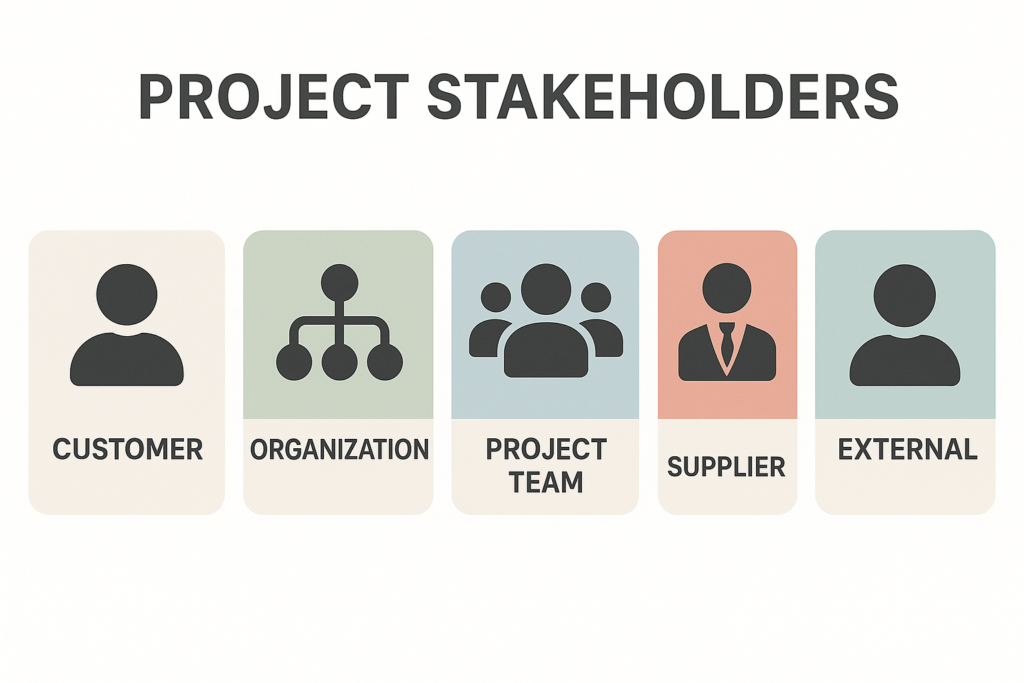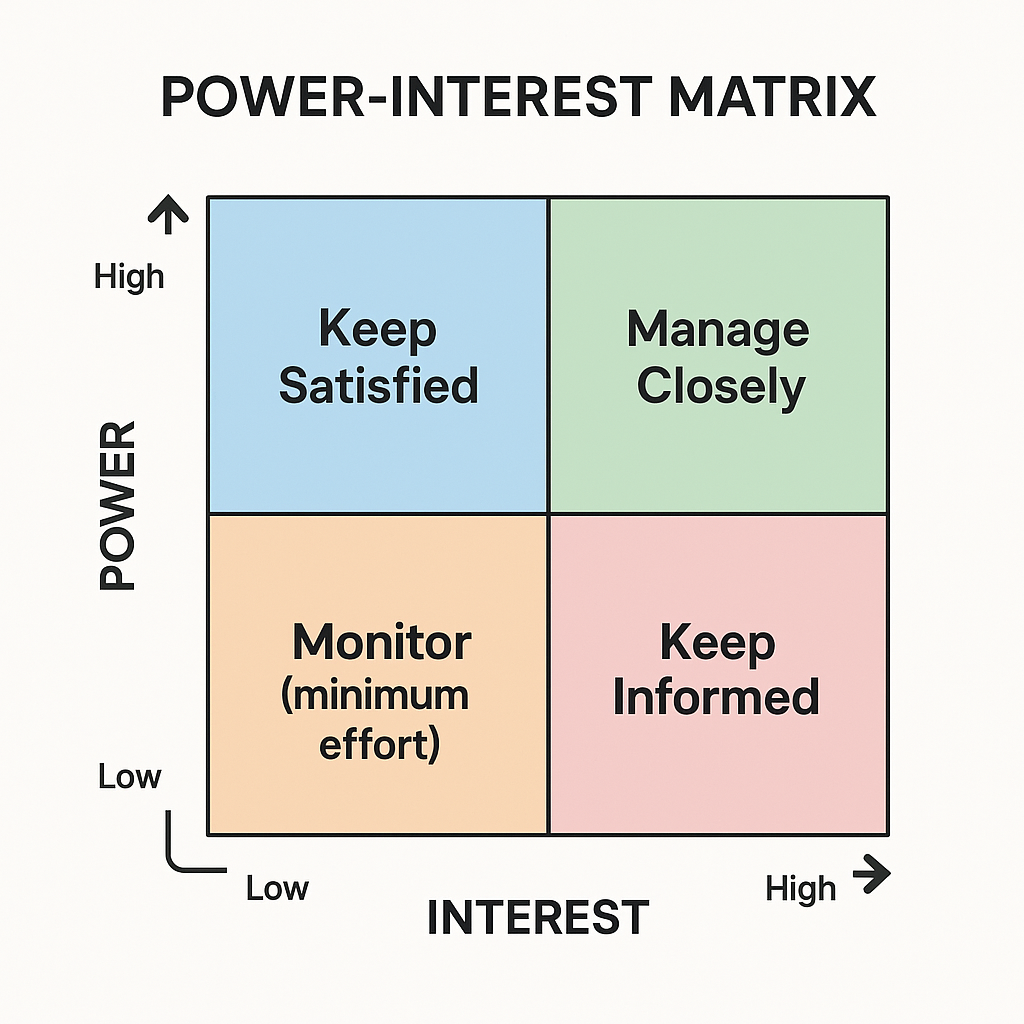
Anybody, who is affected positively or negatively impacted by doing a project, or by not doing a project, by delaying a project is a stakeholder of the project. For example, Owners, Sponsors, Contractors, Sub-contractors, Consultants, Public, Inspection agencies, Environment agencies, Competitors ……
Key stakeholders of projects;
- Owner
- Sponsors
- Consultants (PMC)
- Contractors
- Sub-contractors
- Suppliers
- Citizens
- Users
- Statutory bodies
- Competitors
Project stakeholders are individuals, groups, or organizations that have an interest or are affected by a project’s outcomes, processes, or activities. Stakeholders can influence or be influenced by the project and may have varying levels of involvement, interest, and influence throughout the project lifecycle. Identifying and engaging stakeholders is essential for successful project management and ensuring their needs and expectations are considered and addressed.
For an Engineering, Procurement, and Construction (EPC) project, which typically involves the design, procurement, and construction of a facility or infrastructure, the key stakeholders may include:
- Client/Customer: The organization or entity that initiates and funds the EPC project. They are the primary beneficiary of the project’s deliverables and outcomes.
- Project Sponsor: The individual or group responsible for championing the project within the client organization. The project sponsor provides direction, support, and resources to ensure project success.
- Project Manager: The individual responsible for planning, executing, and managing the EPC project. The project manager serves as the primary point of contact for stakeholders and oversees all project activities.
- Contractors and Subcontractors: Organizations responsible for executing specific tasks or scopes of work within the EPC project. This may include engineering firms, construction companies, equipment suppliers, and other service providers.
- Design Consultants: Engineering firms or consultants responsible for designing the facility or infrastructure being constructed. They develop detailed engineering drawings, specifications, and plans to guide construction activities.
- Regulatory Authorities: Government agencies or regulatory bodies responsible for issuing permits, approvals, and ensuring compliance with applicable laws, regulations, and standards.
- Local Community: Residents, businesses, and community organizations located near the project site. They may be affected by construction activities, noise, traffic, or environmental impacts and may have concerns or interests related to the project.
- Environmental and Social Impact Assessors: Experts responsible for assessing the potential environmental and social impacts of the project and developing mitigation measures to minimize adverse effects.
- Financial Institutions: Banks, investors, or lenders providing financing or funding for the project. They have a vested interest in ensuring the project is completed on time, within budget, and meets agreed-upon financial terms.
- Supply Chain Partners: Suppliers, vendors, and manufacturers supplying materials, equipment, and components for the project. They play a critical role in ensuring timely delivery of goods and materials to support construction activities.
- Labor Unions: Trade unions representing workers involved in construction activities. They may negotiate labor agreements, wages, and working conditions and advocate for the interests of their members.
- Utilities and Infrastructure Providers: Organizations providing essential services such as water, electricity, telecommunications, and transportation. They may need to coordinate with the project team to ensure minimal disruption to their services during construction.
- Government Agencies and Authorities: Besides regulatory authorities, other government agencies may have an interest in the project, such as transportation departments, economic development agencies, or utility regulators.
Key stakeholders for a new product development in IT
For a new product development project in the Information Technology (IT) industry, the key stakeholders may include:
- Product Owner/Product Manager: The individual responsible for defining the product vision, roadmap, and features. They represent the interests of the customer and stakeholders and prioritize the product backlog.
- Development Team: The team of software developers, engineers, designers, and testers responsible for building and delivering the new product. They collaborate with the product owner to implement features and ensure product quality.
- Customers/Users: The end-users or customers who will use the new product. Their feedback and input are crucial for understanding requirements, usability, and functionality.
- Project Sponsor: The individual or group providing funding and support for the project. They champion the project within the organization, provide resources, and ensure alignment with strategic objectives.
- Executive Leadership: Senior executives and decision-makers within the organization who provide oversight and guidance for the project. They may review project progress, provide strategic direction, and make key decisions.
- Marketing Team: The marketing professionals responsible for promoting and positioning the new product in the market. They provide input on product messaging, branding, and go-to-market strategies.
- Sales Team: Sales representatives and account managers who sell the new product to customers. They provide insights into customer needs, preferences, and competitive landscape.
- Customer Support/Service: The customer support team responsible for assisting users with product-related inquiries, issues, and feedback. They play a role in gathering customer feedback and identifying areas for improvement.
- Quality Assurance/Testing Team: The team responsible for testing the new product to ensure it meets quality standards and functionality requirements. They identify bugs, defects, and usability issues and collaborate with the development team to resolve them.
- IT Operations/Infrastructure Team: The team responsible for deploying, hosting, and maintaining the new product in production environments. They ensure the product is available, secure, and scalable for users.
- Legal and Compliance: Legal advisors and compliance officers who ensure the new product complies with relevant laws, regulations, and industry standards. They may review contracts, licenses, and data privacy policies.
- Business Analysts: Professionals who analyze business needs, requirements, and market trends to inform product decisions. They gather and document requirements, conduct market research, and define user stories.
- Finance Team: The finance department responsible for budgeting, financial forecasting, and cost management for the project. They provide financial analysis and reporting to ensure the project stays within budget.
- External Partners and Vendors: External vendors, consultants, or partners who provide expertise, technology, or services to support the new product development project.
Identifying and engaging these key stakeholders early in the project planning process allows project managers to understand their needs, expectations, and concerns and to develop strategies to manage stakeholder relationships effectively throughout the project lifecycle. Effective stakeholder management is essential for mitigating risks, resolving conflicts, and ensuring project success.
Stakeholder register
A stakeholder register is a document used in project management to capture and organize information about project stakeholders. It serves as a central repository for key stakeholder details and helps project managers and teams effectively identify, analyze, and manage stakeholders throughout the project lifecycle.
The stakeholder register typically includes the following information for each stakeholder:
- Stakeholder Identification:
- Name: The name or title of the stakeholder.
- Role/Position: The role or position of the stakeholder within the organization or project.
- Organization: The organization or entity that the stakeholder represents.
- Contact Information:
- Contact Details: Email address, phone number, mailing address, or other relevant contact information for the stakeholder.
- Preferred Communication Method: The stakeholder’s preferred method of communication, such as email, phone, meetings, or others.
- Stakeholder Classification:
- Internal/External: Whether the stakeholder is internal to the organization or external (e.g., clients, customers, vendors, regulators).
- Influence/Interest: An assessment of the stakeholder’s level of influence on the project and their level of interest or involvement.
- Stakeholder Analysis:
- Stakeholder Expectations: The stakeholder’s expectations, needs, interests, and concerns related to the project.
- Impact: The potential impact of the stakeholder on the project’s success and outcomes.
- Engagement Strategy:
- Engagement Plan: Strategies and approaches for engaging with each stakeholder, including communication frequency, methods, and key messages.
- Stakeholder Management Strategy: Plans for managing stakeholder expectations, addressing concerns, and building relationships.
- Stakeholder Assessment:
- Stakeholder Power/Influence: The stakeholder’s level of power or influence over project decisions and outcomes.
- Stakeholder Interest/Impact: The stakeholder’s level of interest in the project and the potential impact of the project on them.
- Additional Notes/Comments:
- Any additional information, notes, or comments relevant to the stakeholder’s involvement in the project.
The stakeholder register is a dynamic document that is updated and refined throughout the project lifecycle as new stakeholders are identified, stakeholder relationships evolve, and project requirements change. It serves as a valuable tool for project managers and teams to ensure effective stakeholder engagement, communication, and management, ultimately contributing to project success.
Stakeholder classification

Stakeholder classification involves categorizing stakeholders based on various criteria, such as their level of influence, interest, involvement, and relationship with the project. This classification helps project managers and teams understand stakeholders’ roles, priorities, and potential impact on the project. Here are some common approaches to stakeholder classification:
- Internal vs. External:
- Internal Stakeholders: Individuals or groups within the organization directly impacted by the project, such as employees, managers, executives, and departments.
- External Stakeholders: Individuals or entities outside the organization who have an interest in or are affected by the project, including clients, customers, vendors, suppliers, regulators, shareholders, community groups, and the public.
- Primary, Secondary, Tertiary:
- Primary Stakeholders: Individuals or groups directly involved in or affected by the project and have significant influence over its outcomes. They often include project sponsors, customers, end-users, and key decision-makers.
- Secondary Stakeholders: Individuals or groups indirectly impacted by the project or with less influence but still have an interest in its outcomes. This may include support staff, contractors, and other departments.
- Tertiary Stakeholders: Individuals or groups with minimal or indirect influence and interest in the project, such as regulatory agencies, industry associations, or advocacy groups.
- Power/Influence vs. Interest:
- High Power/High Interest: Stakeholders with significant power and high interest in the project’s success. They often include project sponsors, senior executives, and major customers.
- High Power/Low Interest: Stakeholders with significant power but low interest in the project. They may include regulatory authorities, government agencies, or legal teams.
- Low Power/High Interest: Stakeholders with limited power but high interest in the project. This category may include user groups, community organizations, or project team members.
- Low Power/Low Interest: Stakeholders with limited power and low interest in the project. They may include peripheral departments, casual observers, or low-level employees.
- Influence vs. Impact:
- Influential Stakeholders: Individuals or groups with the ability to influence project decisions, outcomes, or resources. They may include project sponsors, key executives, or influential customers.
- Impactful Stakeholders: Individuals or groups whose actions or decisions can significantly affect the project’s success or outcomes. This may include end-users, regulatory bodies, or external partners.
- Supportive, Neutral, or Oppositional:
- Supportive Stakeholders: Individuals or groups who actively support the project’s objectives and outcomes. They may provide resources, expertise, or advocacy for the project’s success.
- Neutral Stakeholders: Individuals or groups who are neither supportive nor opposed to the project. They may have limited interest or involvement in the project’s outcomes.
- Oppositional Stakeholders: Individuals or groups who oppose the project or its objectives. They may have concerns, objections, or conflicts of interest that could impede project progress.
By classifying stakeholders using these criteria, project managers can prioritize their engagement efforts, tailor communication strategies, and effectively manage stakeholder relationships to ensure project success.
